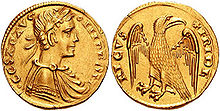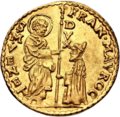Augustalis

An augustalis or augustale, also agostaro, was a gold coin minted in the Kingdom of Sicily beginning in 1231.[1]
History
It was issued by Frederick II, Holy Roman Emperor (from 1220) and King of Sicily (from 1198), and was minted until his death in 1250.[2][3] In addition, a half augustalis was issued. It was identical in design, but smaller and half the weight.[4] The augustalis bore a Latin inscription and was widely circulated in Italy. It was patterned after the Roman aureus.[5] It was struck at Brindisi and Messina with accompanying billon deniers.[5] The style of the augustalis has been described as splendid and proto-Renaissance; the quality of its execution and its fineness was high.[5] The augustalis had a nominal weight of 5.31 grams and was 201⁄2 carats (854/1000) fine.[4] The legal value was a quarter of a Sicilian gold ounce.[4]
The obverse contains a classical (not medieval) profile bust of the emperor wearing a laureate wreath with the legend CESAR AVG IMP ROM (Caesar Augustus, Emperor of the Romans); the reverse shows an eagle, the imperial symbol, with the name FRIDE RICVS (Frederick).[6][4] The name augustalis means literally "of the august one", referring to the coin's provenance from the emperor himself, but also linking it with the Roman Emperor, who was commonly styled Augustus.
See also
References
- ^ Grierson, Philip; Travaini, Lucia (1998). Medieval European Coinage. Volume 14: Italy III: South Italy, Sicily, Sardinia. Cambridge University Press. p. 455. ISBN 978-0-521-58231-5.
- ^ Abulafia, David (1992). Frederick II: A Medieval Emperor (Oxford Paperbacks ed.). Oxford University Press. p. 222. ISBN 978-0-19-508040-7.
The augustalis continued to be struck in the regno throughout the rest of the reign, and was even continued by later kings.
- ^ Grierson, Philip; Travaini, Lucia (1998). Medieval European Coinage. Volume 14: Italy III: South Italy, Sicily, Sardinia. Cambridge University Press. p. 187. ISBN 978-0-521-58231-5.
Sambon and others have supposed that augustales in Frederick's name continued to be issued [by his successors] down to 1266, which is possible but unsupported by positive evidence.
- ^ a b c d Grierson, Philip; Travaini, Lucia (1998). Medieval European Coinage. Volume 14: Italy III: South Italy, Sicily, Sardinia. Cambridge University Press. p. 172. ISBN 978-0-521-58231-5. [Errata: Gold content of 4.33g should read 4.53g; obverse referred to as reverse, and vice versa; CESAR misquoted as CAESAR.]
- ^ a b c Augustale at the Encyclopædia Britannica (2008). Retrieved 7 October 2008.
- ^ Abulafia, David (1992). Frederick II: A Medieval Emperor (Oxford Paperbacks ed.). Oxford University Press. p. 222. ISBN 978-0-19-508040-7. [Erratum: CESAR AVG misquoted as CESAVG.]
External links
- An augustalis at the Kunsthistorisches Museum Vienna
- A half augustalis at the American Numismatic Society
- Kowalski, H. (1976). "Die Augustalen Kaiser Friedrichs II". Schweizerische Numismatische Rundschau (in German). 55: 77–150. doi:10.5169/seals-174259. - comprehensive study

